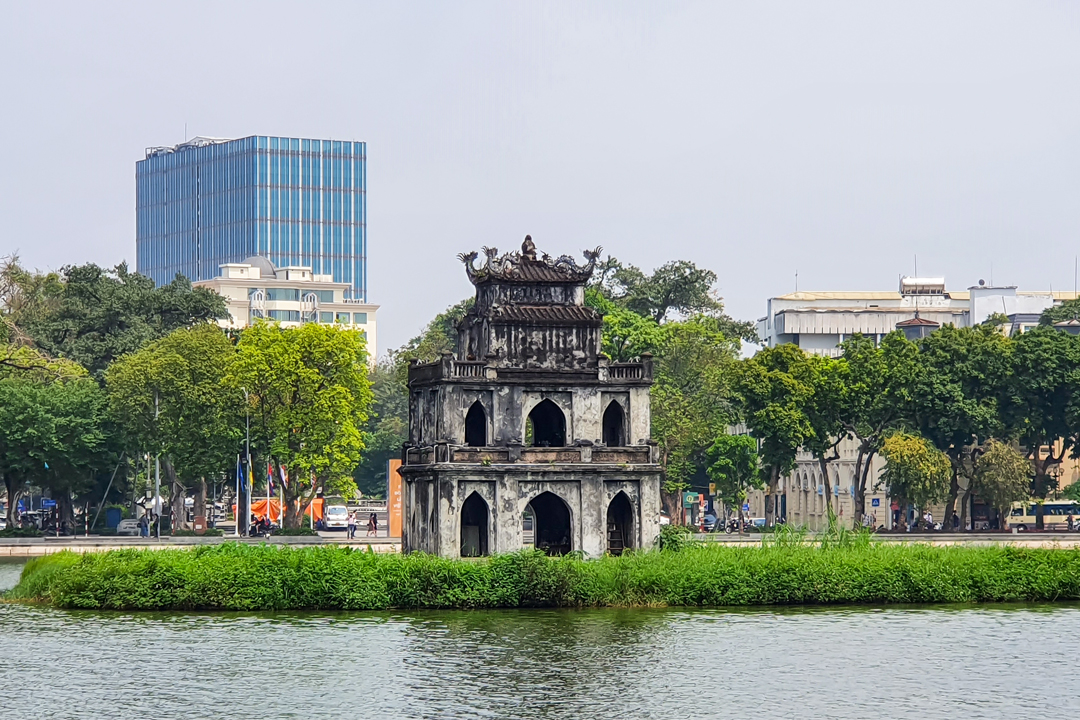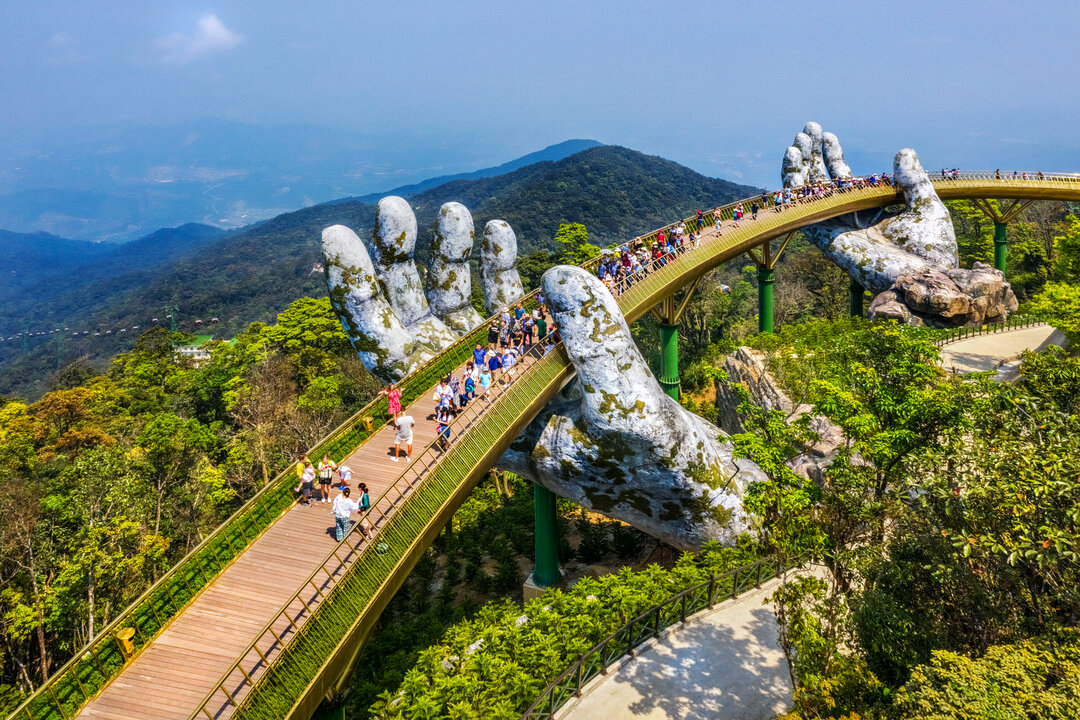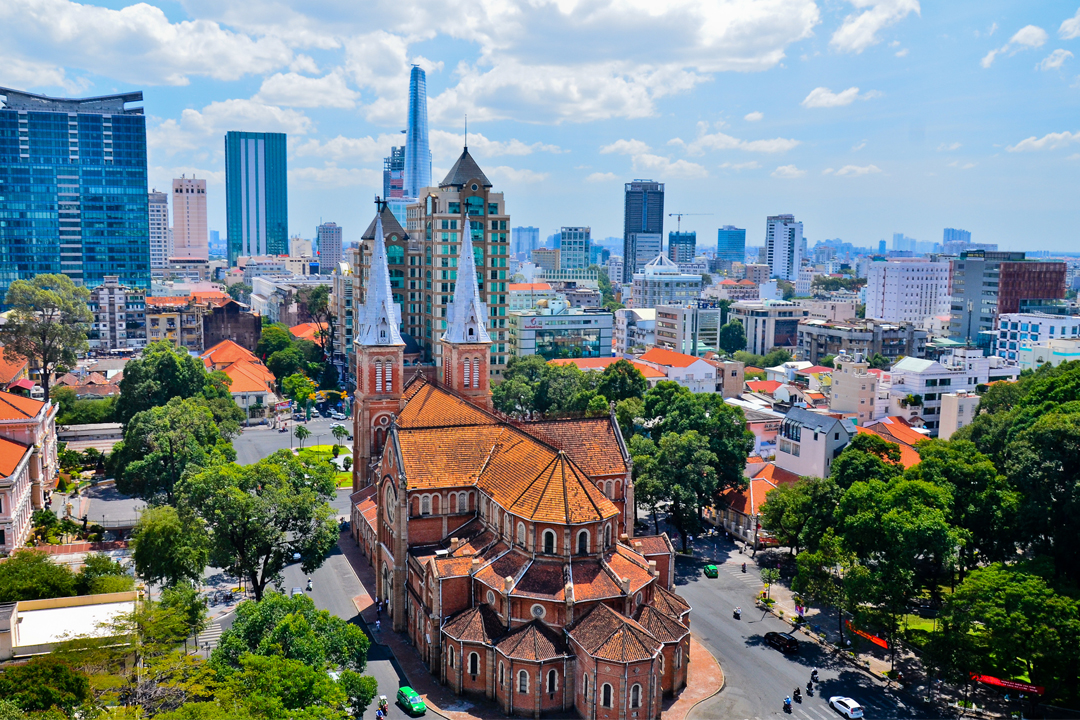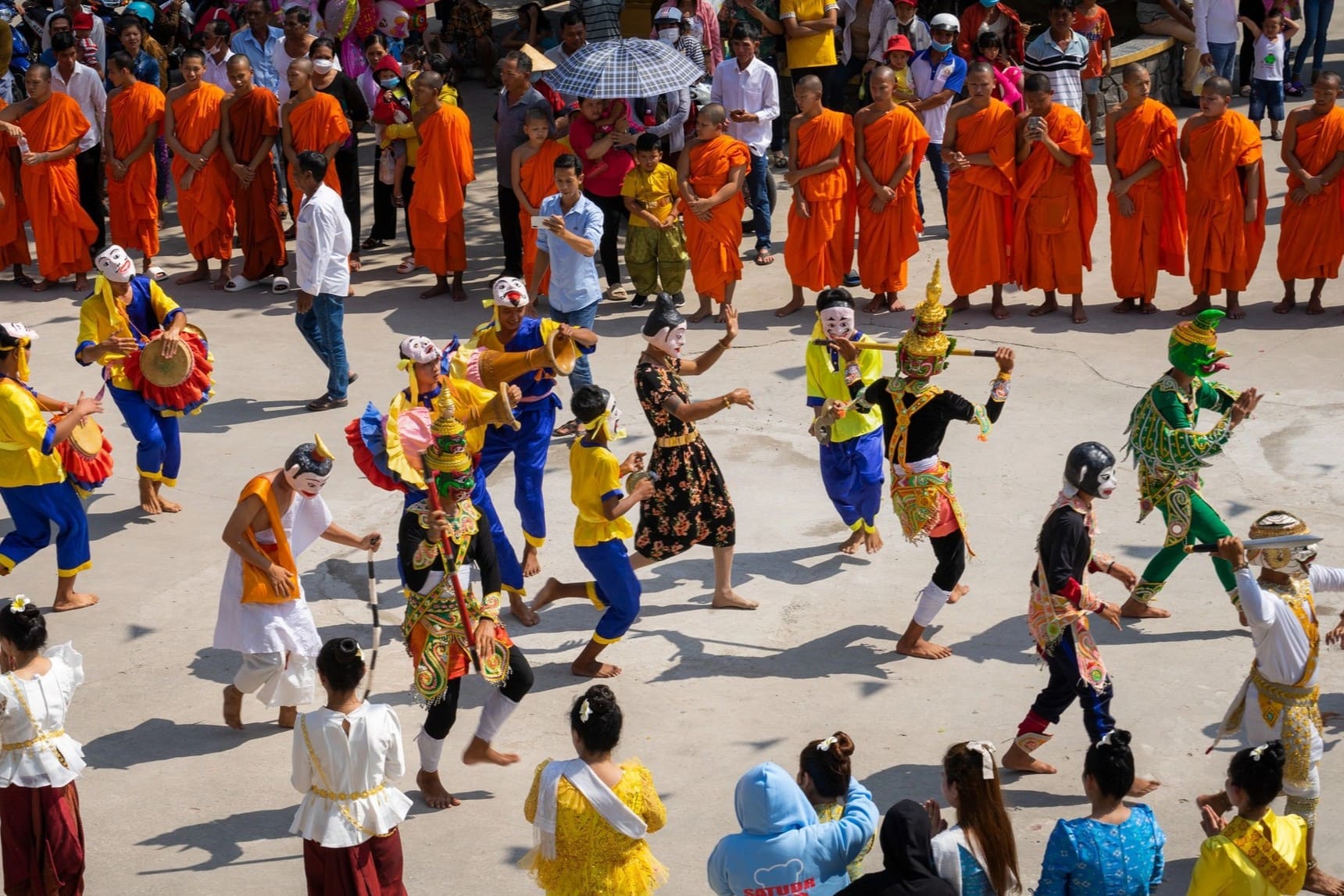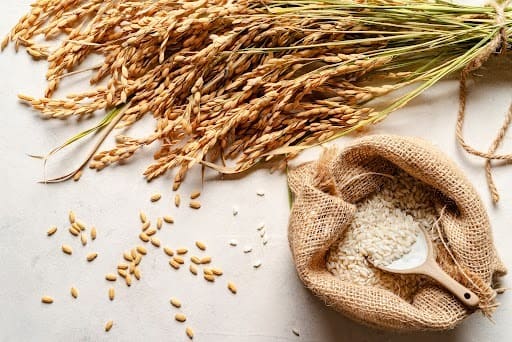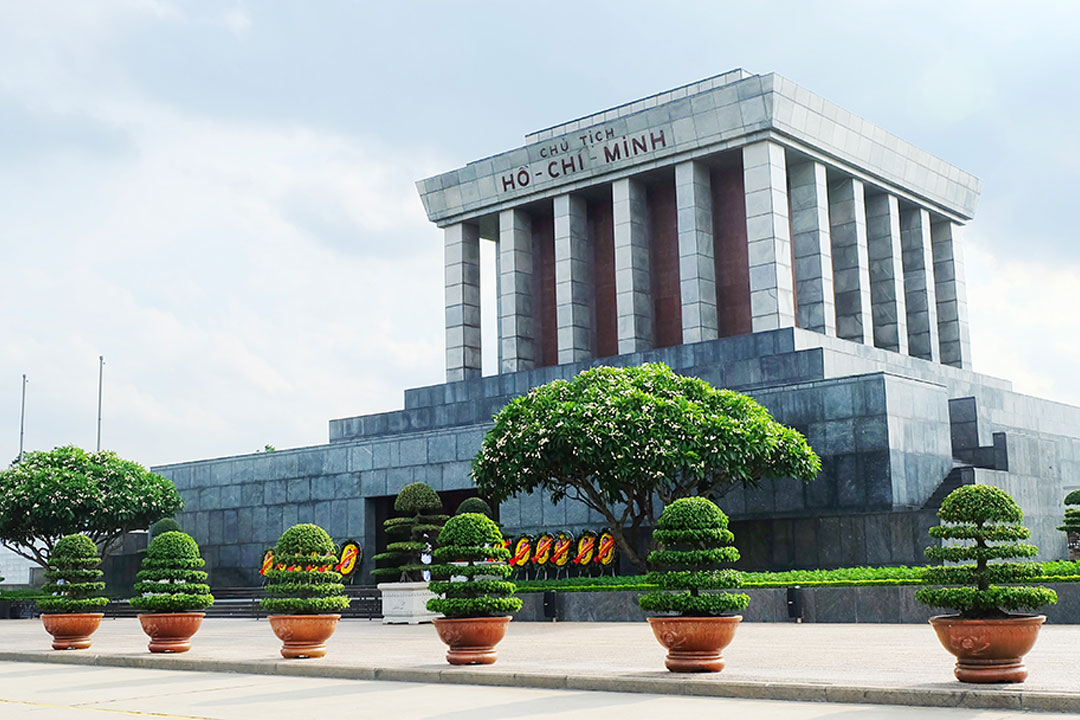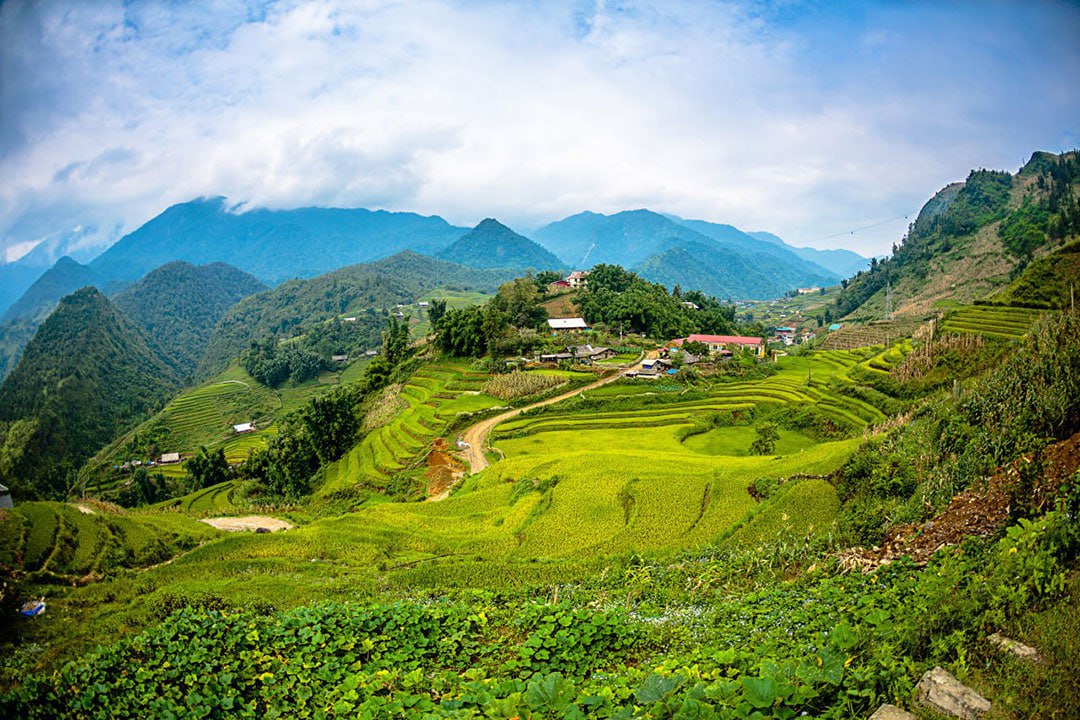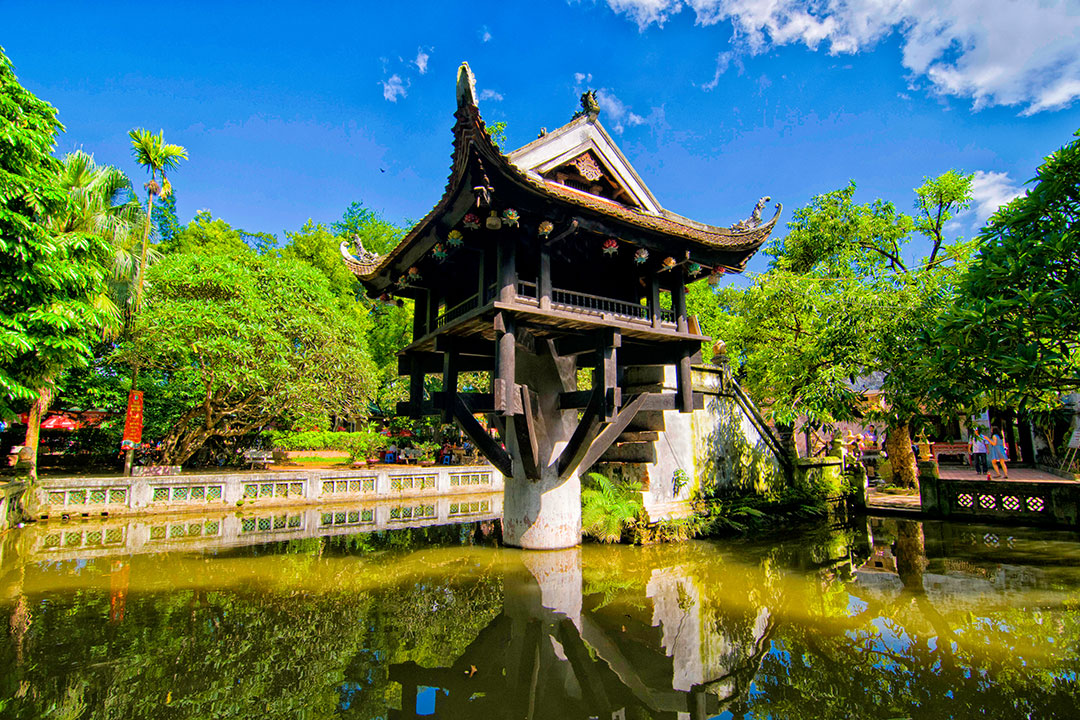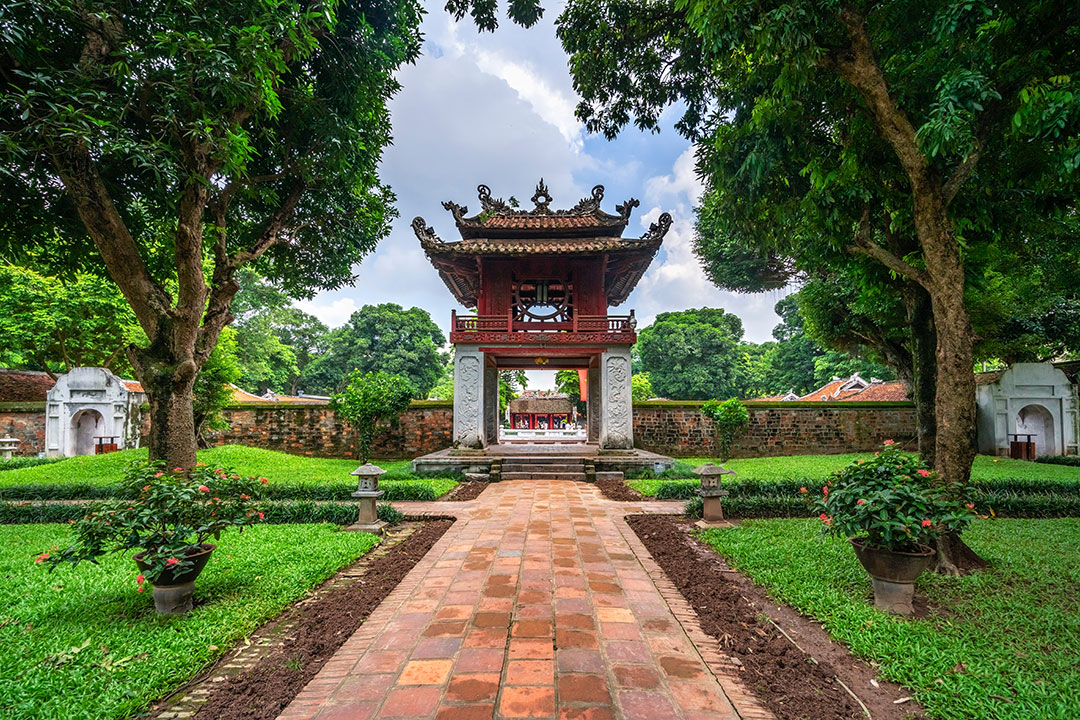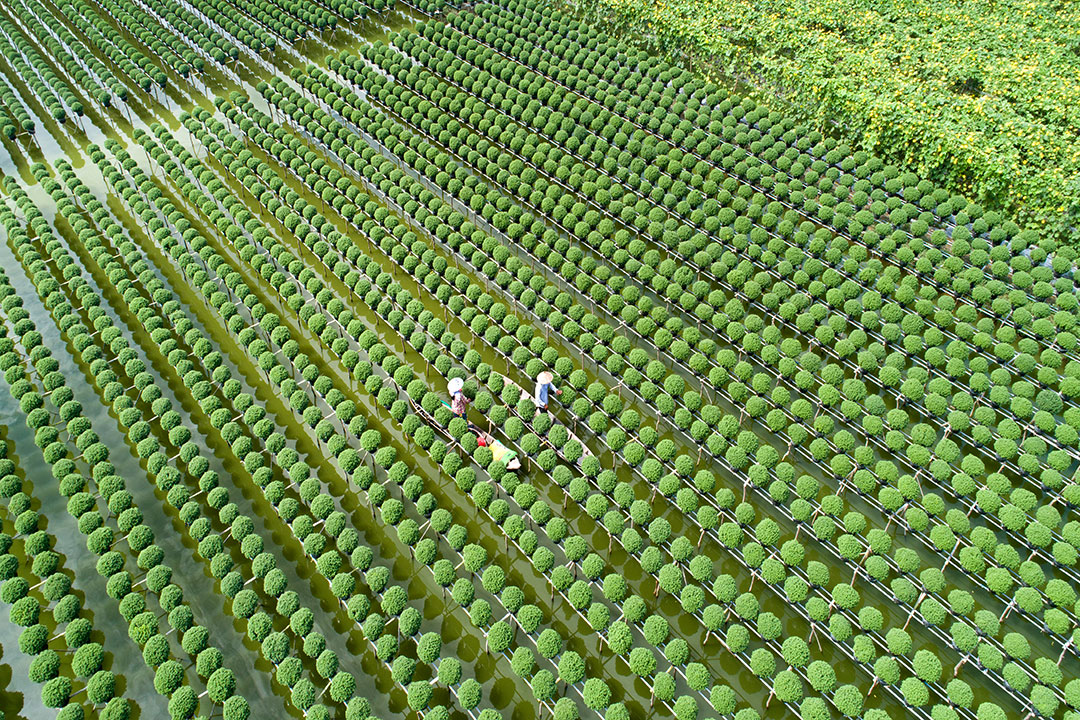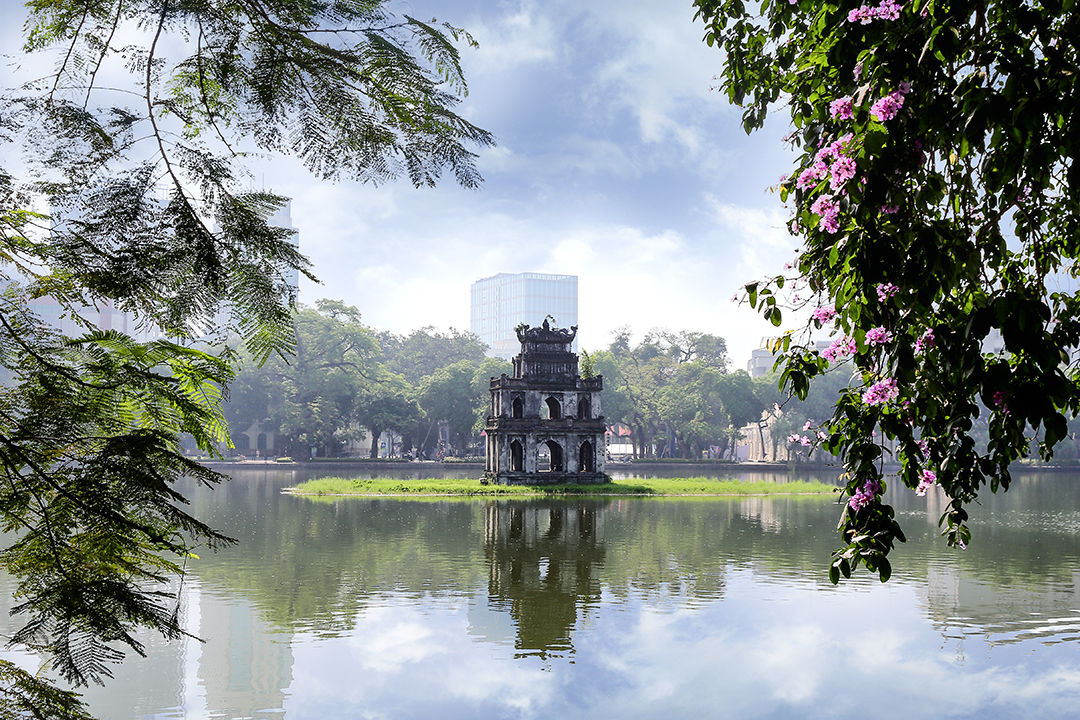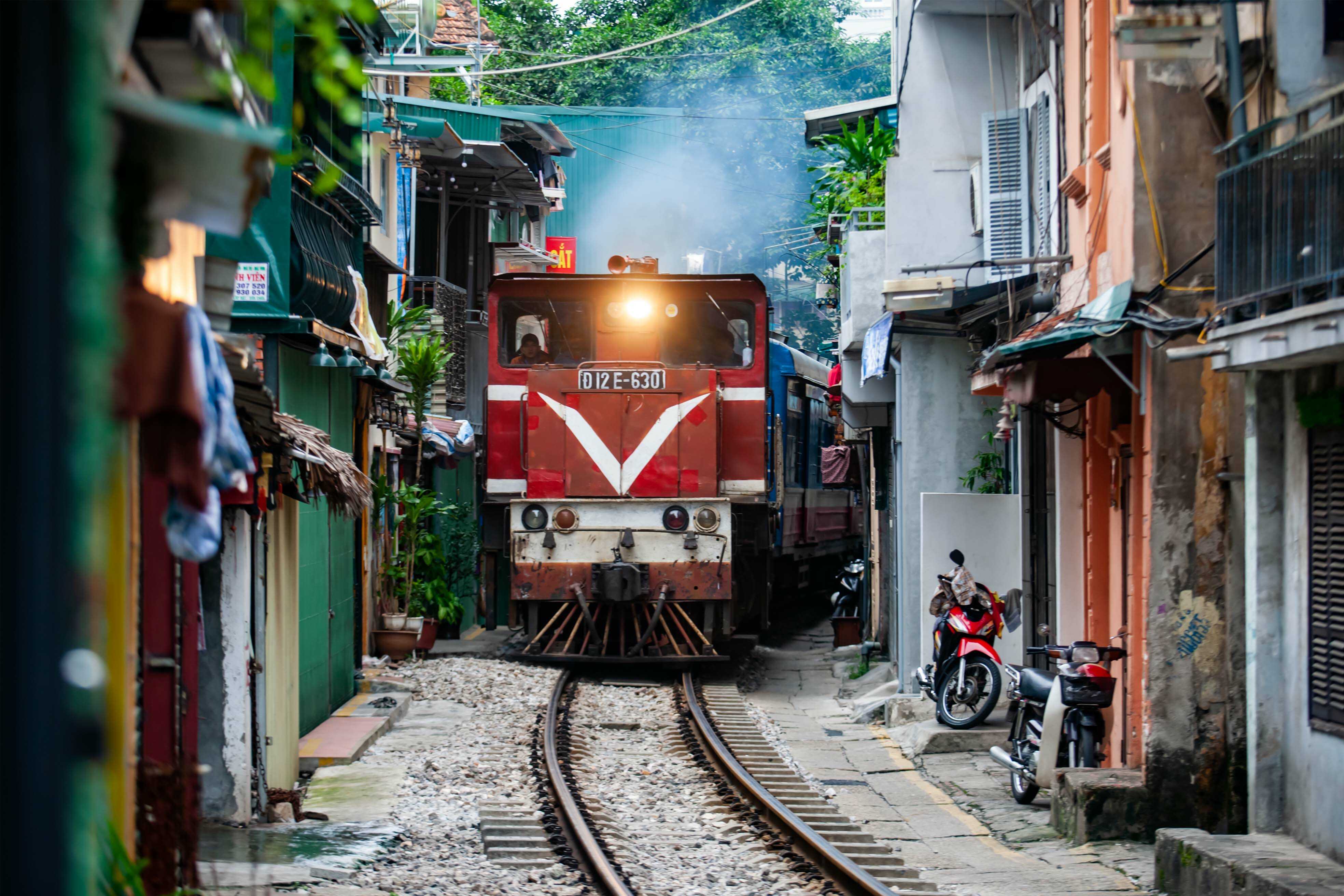Hanoi Old Quarter: Things To Do & Travel Guide, 36 Streets List
Nestled in the heart of Hanoi, the Hanoi Old Quarter is a bustling tourist hub - a living testament to the city's rich cultural tapestry and historical evolution. Wandering its maze-like streets, tourists discover a blend of ancient Vietnamese architecture, French colonial flair, and lively street life. This area has been the heartbeat of Hanoi for centuries, where craftsmen, traders, and local communities have shaped its dynamic yet enduring identity. Beyond typical guides, this journey uncovers the Old Quarter’s hidden stories, cultural layers, and ties between its past and present. Ready to discover the secrets that make this district more than just a tourist stop?
Overview of the Hanoi Old Quarter
Location: The center of Hoan Kiem District, located just north and west of Hoan Kiem Lake
The Hanoi Old Quarter is a living testament to Vietnam's vibrant and enduring cultural heritage. This district is more than just a tourist attraction, it is a historical epicenter where the essence of the city's past and present coexist. Despite modern changes, the Old Quarter retains its charm with maze-like streets, colonial buildings, and lively traditional markets. The area is renowned for its "36 streets", each historically associated with a specific trade or craft, such as silverware, silk, and herbal medicine.
The Old Quarter's layout, a seemingly chaotic network of narrow lanes, is a reflection of its long history of commercial exchange. This labyrinth of alleys and shophouses has remained largely intact despite the city's rapid urbanization. The architecture blends traditional Vietnamese design and French colonial influence, best seen in the iconic tall, narrow “tube houses” with extended facades. While modernization has led to the construction of contemporary buildings, efforts to preserve the historical essence of the area have been prioritized.
A significant aspect of the Old Quarter’s allure lies in its role as a cultural and social hub for both locals and visitors. Streets are lined with street food vendors serving iconic Vietnamese dishes like pho, bun cha, and banh mi. Traditional craft shops sell handmade souvenirs, lacquerware, and intricate embroidery.
The Hanoi Old Quarter plays a pivotal role in shaping the cultural identity of Hanoi. It stands as a historical district and as a symbol of the city’s resilience and adaptability. Despite the influx of tourism, the community spirit and traditional practices persist, creating a dynamic yet grounded atmosphere. For those seeking a deeper understanding of Hanoi's cultural fabric, the Old Quarter offers an immersive experience that bridges the past and the present.
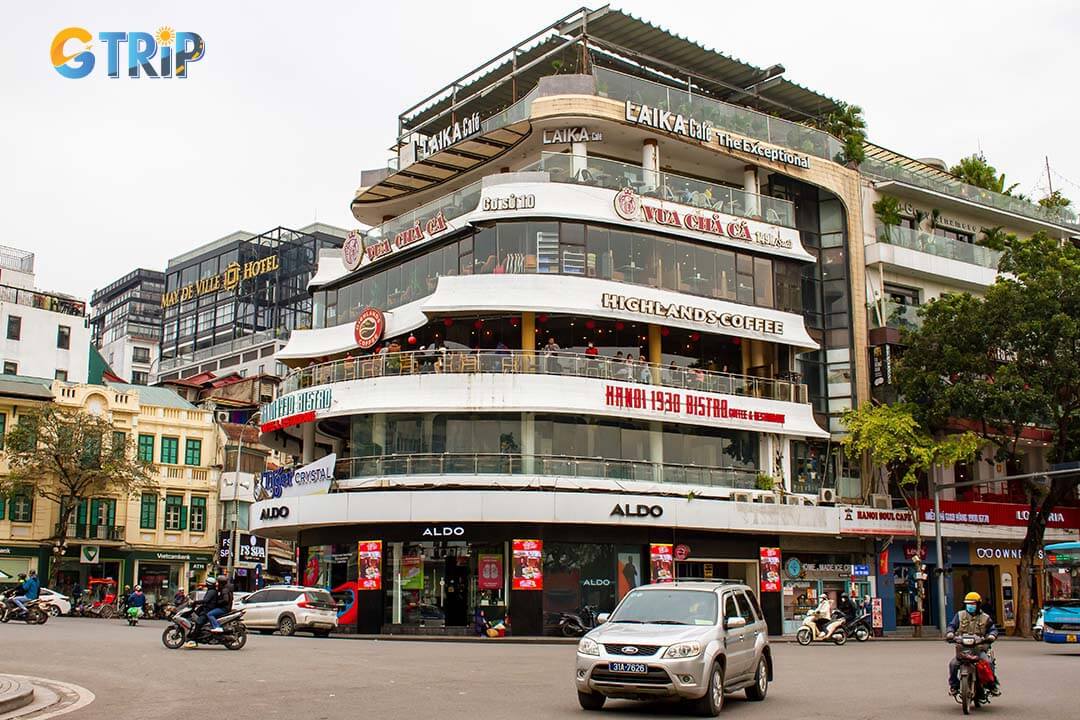
The Hanoi Old Quarter is a cultural hub where historic trades, colonial architecture, and modern life come together across its iconic 36 streets
Historical background and evolution of Hanoi Old Quarter
The Hanoi Old Quarter's historical background and evolution can be explored through its colonial influences and preservation efforts. It also showcases a seamless blend of ancient traditions with modern developments.
Colonial influence and French architectural imprints
The Hanoi Old Quarter’s history is deeply influenced by its French colonial past from the late 19th to mid-20th century. The French aimed to modernize Hanoi while maintaining control, resulting in a unique blend of traditional Vietnamese and European architectural styles. This contrast is clear in the Old Quarter, where French-style facades with balconies and shutters sit next to traditional tube houses built for trade.
French colonial policies also influenced the urban planning of the area. Streets were restructured and renamed to fit administrative needs, while French cultural institutions, such as theaters and clubs, emerged, catering primarily to the European elite. However, the traditional market streets endured, adapting to the new urban framework. This blending of Vietnamese resilience and French sophistication created a distinctive atmosphere that remains a hallmark of the Old Quarter today.
Preservation efforts and heritage conservation
Over the decades, Hanoi's rapid modernization has threatened the preservation of the Old Quarter's historical integrity. In the early 1990s, the Vietnamese government launched efforts to preserve the Old Quarter’s historic architecture while balancing urban development. Policies were introduced to preserve significant landmarks, such as the Ma May Ancient House, a well-preserved example of a traditional Vietnamese dwelling adapted to colonial influences.
Local authorities collaborated with international organizations to develop sustainable tourism models that balance heritage conservation and economic development. The "36 Streets" focused on revitalizing specific trade streets, encouraging the continuation of traditional crafts while introducing modern amenities to enhance the tourism experience. Despite these efforts, the Old Quarter faces ongoing challenges related to over-tourism, infrastructure strain, and the tension between preservation and commercialization.
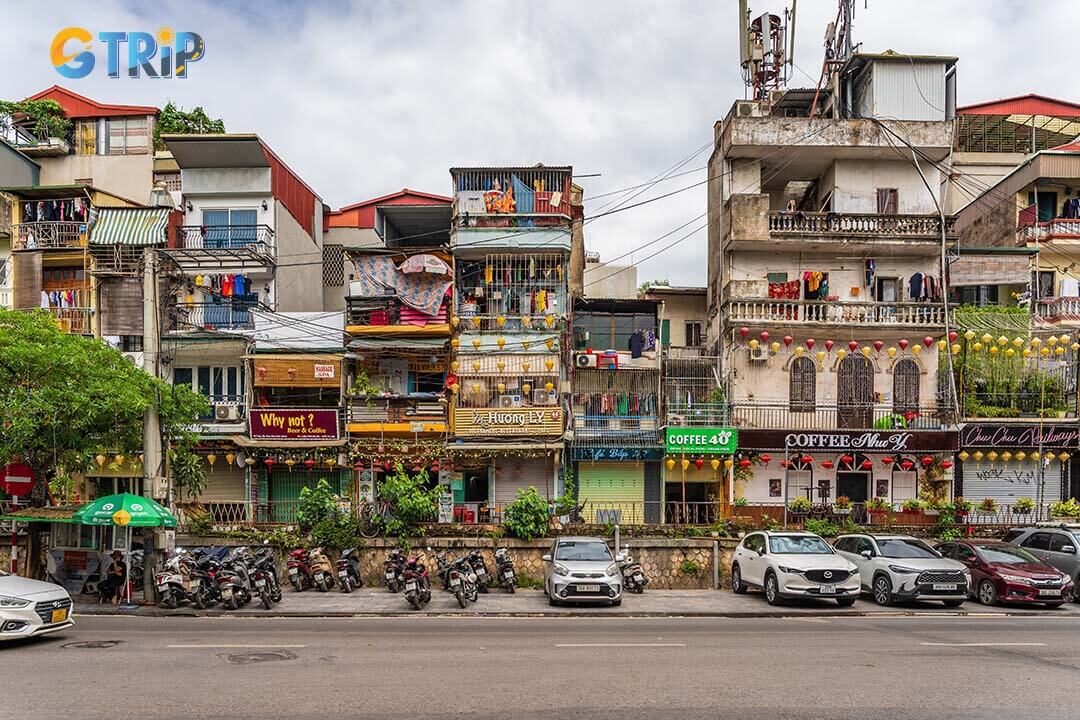
Since the 1990s, Hanoi has worked to preserve the Old Quarter's heritage, though it still faces pressure from tourism and urban growth
Evolution from ancient times to the modern era
The origins of the Hanoi Old Quarter trace back to the 11th century during the Ly Dynasty, when the area served as a bustling trade hub linked to Thang Long Citadel. Merchants and artisans formed trade guilds, giving rise to the "36 Streets", each named after the goods once made or sold there. For centuries, the Old Quarter functioned as the economic heart of Hanoi, with generations of craftsmen and traders passing down their skills.
Throughout its evolution, the Old Quarter has adapted to shifting economic and political dynamics. The post-colonial era and Vietnam's Reunification in 1975 brought significant changes, as state control over commerce impacted traditional trading practices. However, the economic reforms of the "Doi Moi" period in the late 1980s revitalized the area, ushering in private enterprise and a renewed focus on tourism.
Today, the Old Quarter represents a living museum of Hanoi's past while embracing modern development. You can experience a blend of history and contemporary life, from ancient temples like Bach Ma Temple to vibrant night markets that reflect the district's commercial spirit. Despite its evolution, the Old Quarter maintains a sense of cultural authenticity, offering insights into the endurance and adaptability of Hanoi’s people.
36 Streets of Hanoi Old Quarter
The origins of the 36 streets can be traced back to the 11th century when Hanoi, then known as Thang Long, began to establish itself as a vital center of trade and politics. Artisans and merchants from various rural areas migrated to the city, forming communities based on shared trades. These communities, often associated with specific guilds, settled in designated streets where their crafts could be practiced collectively and traded efficiently.
The term "Hang", meaning "goods" or "merchandise", is a defining prefix for many street names within the Old Quarter. Streets like Hang Bac (Silver Street), Hang Dao (Silk Street), and Hang Ma (Paper Offerings Street) vividly reflect the specialties of the artisans who once thrived there. The development of these trade streets was not arbitrary; it followed a structured plan designed to streamline commerce and protect each guild’s economic interests. Below are the names of 36 streets, along with the unique characteristics of each place:
- 1. Hang Buom Street: Originally known for producing boat sails, mats, baskets,... , this street’s traditional craft has largely given way to modern retail. Today, many shops sell sweets, cakes, and assorted goods- even as echoes of its sail‐making past remain in local lore.
- 2. Hang Ngang Street: Famous for its mix of local retail stores offering a wide range of goods and currently dealing in high-end, luxury clothing and branded goods. There are also some portrait shops on the street.
- 3. Hang Ma Street: Has a history associated with specialized crafts for worship and paper decorations. So this place is often crowded every time Tet comes.
- 4. Hang Mam Street: Known for selling various fermented seafoods like shrimp paste in jars, fish sauce stored in buried casks, and salt-roasted crab. Though its original trade has faded, it now features shops selling tombstones, ceramics, and earthenware.
- 5. Hang Trong Street: Known for its rich history and proximity to the city center. Once famous for embroidery, drum-making, and especially traditional Hang Trong paintings, the street still attracts tourists despite the decline of its traditional crafts. Today, it remains a cultural stop where tourists can explore art workshops, religious sites like Nam Huong Pagoda, and get a glimpse of Hanoi’s artistic heritage.
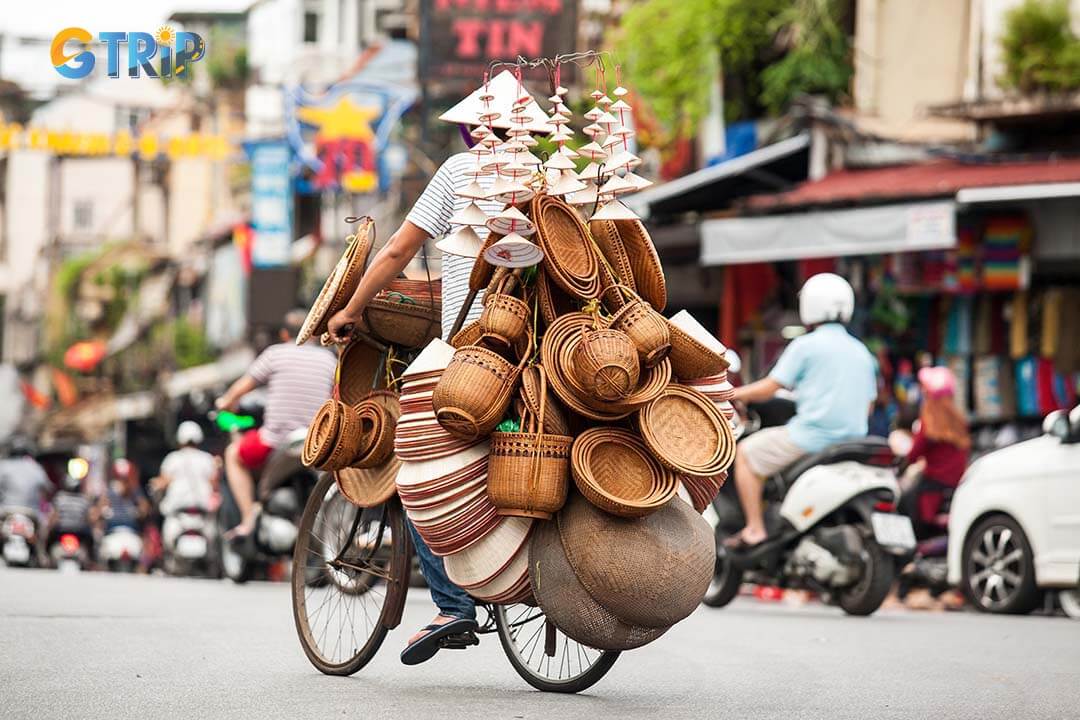
Hang Trong Street is a culturally rich destination near the city center, known for its artistic legacy, traditional crafts, and historic sites
- 6. Hang Be Street: In the past, this area served as a riverside trading hub where timber rafts and building materials from upstream were brought in for sale, hence the name “Hang Be”. Today, although modern life has transformed much of the Old Quarter, Hang Be still retains a touch of its historic charm, offering tourists a glimpse into Hanoi’s past and its bustling market traditions.
- 7. Hang Bo Street: Stretches about 270 meters and was historically known for selling bamboo and rattan items like baskets and trays. Once called "Rue des Paniers" during French rule, it specializing in footwear. Today, it remains a bustling trade area with historical sites like the Nhan Noi Temple.
- 8. Hang Bac Street: Famous for silver jewelry and handicrafts, this street has long been the center for silver trade in Hanoi.
- 9. Hang Giay Street: Once famous for its paper products, stationery and traditional printing, this place used to be the center of paper production and related crafts. Currently, the goods that appear a lot are shoes, watches, phones, fashion, …
- 10. Ma May Street: The street name is a combination of Hang Ma and Hang May streets. This street used to specialize in making votive offerings, paper offerings for funerals, processions, and also making rattan items. But now, it is mainly motels, hotels, offices, and restaurants serving tourists, so most of the guests here are foreigners.
- 11. Dong Lac Street: This place is famous for the Dong Lac communal house, which used to sell yarn and women's clothing. Now, this street belongs to Hang Dao Street. The historical details are recorded in the stone stele erected in Tu Duc year - Binh Thin (1856) in the Dong Lac communal house.
- 12. Hang Dao Street: Previously, the street specialized in dyeing and selling red, pink, peach, and other colorful fabrics. The street now sells clothing, utensils, gold and silver, handicrafts, and high-end and luxury goods rather than fabrics.
- 13. Hang Chieu Street: In the past, this place mainly sold sedge mats and bowls, so it was also called Hang Bat Street. Up to now, this place sells blankets, mats, pillows, etc.
- 14. Lan Ong Street (Phuc Kien): Famous for its traditional oriental medicine shops from the past and still maintaining the traditional profession, so when you come here you will smell the characteristic scent of spices and dried herbs from oriental medicine in the air.
- 15. Nguyen Du Street: A major commercial thoroughfare named after the famed poet, it now blends historical charm with modern dining and retail. (This street is not included in the Old Quarter).
- 16. Hang Lam Street: During the feudal period, it was associated with textile-related industries such as dyeing and producing special blue and sky-blue fabrics reserved for mandarins with titles. However, because the dyers had long since left, this street no longer had a name and had to borrow the name of Dien Hung, the local ward, to call it.
- 17. Dong Xuan Street: Home to the famous Dong Xuan Market, this busy street remains a vital center for wholesale and retail trade in a wide range of goods.
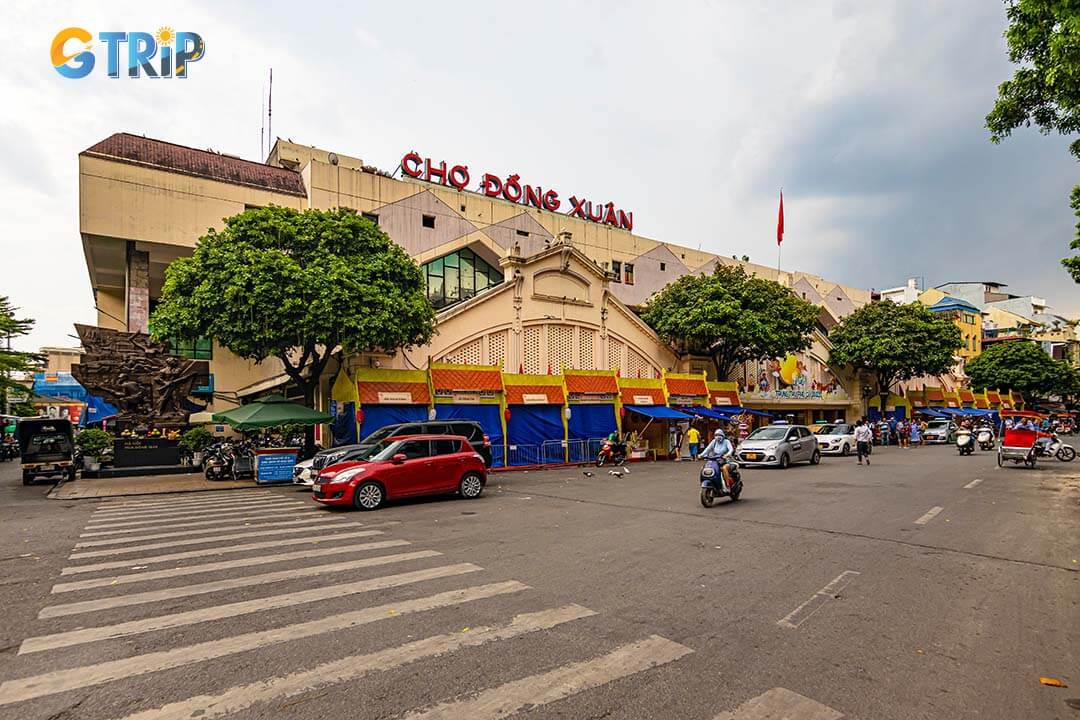
Home to Dong Xuan Market, this bustling street is a key hub for wholesale and retail trade in Hanoi
- 18. Thanh Ha Street: Also known as Dioscorea cirrhosa street because there used to be many people selling Dioscorea cirrhosa (used to dye brown fabric). Now this place has become a place to provide food and drink, from raw to cooked food, from pre-processed to ready-to-eat dishes.
- 19. Hang Gai Street: Renowned for its silk products, tailoring, and garments, this street has long been the heart of the silk trade.
- 20. Hang Day Street: Previously, there was the largest Hang Day stadium in Hanoi, and this place specialized in selling "day", which is a type of container made of fabric such as a bag, a sack or a backpack. Now it is called Nguyen Thai Hoc Street, with many shops selling copied paintings and advertising designs.
- 21. Hang Che Street: Currently called Ho Hoan Kiem Street. Often known for its street food stalls selling banh bot loc, nem chua ran, nem cuon... especially the "specialty" dried beef salad, reflecting the traditional flavors and culinary heritage of Vietnam.
- 22. Hang Muoi Street: According to information, this is a place where there is no salt trade but there will be a few households that trade salt and sell to wholesalers and retailers in the markets.
- 23. Quang Minh Street Dinh: (This street is not one of the 36 streets in the Old Quarter)
- 24. Hang Duong Street: Traditionally associated with the food trade such as confectionery, products made from molasses, rock sugar, and cane sugar and until now, there are still many shops selling special candies including "o mai", which can be roughly translated as salted dry apricot.
- 25. Hang Manh Street: Famous for selling curtains with materials such as hooks and bamboo often used to shade porches, separate private rooms, etc.
- 26. Hang Hom Street: With a combination of antique shops and traditional craft shops, this street evokes the original cultural essence of the Old Quarter. In the past, this place specialized in trading lacquered wooden items, from black lacquered wooden boxes, wooden boxes for storing clothes, paper and pen boxes, to lacquered wooden boxes. Currently, the trade in lacquered wooden items is still maintained with more sophistication and eye-catching.
- 27. Hang Ga Street: This street was previously associated with the trading of poultry such as chickens, ducks, geese, and pigeons, hence its name.
- 28. Hang Dong Street: A street that has long been famous for its production and trade of copper utensils such as trays, pots, pans,... to incense burners, incense burners, and incense bowls collected from the craft villages of He Nom and Ngu Xa.
- 29. Hang Non Street: Famous for its hat-making craft from ancient times with wide-brimmed hats and gradually developing with different types of hats. Nowadays, there are also shops selling handmade hats, accessories and bedding.
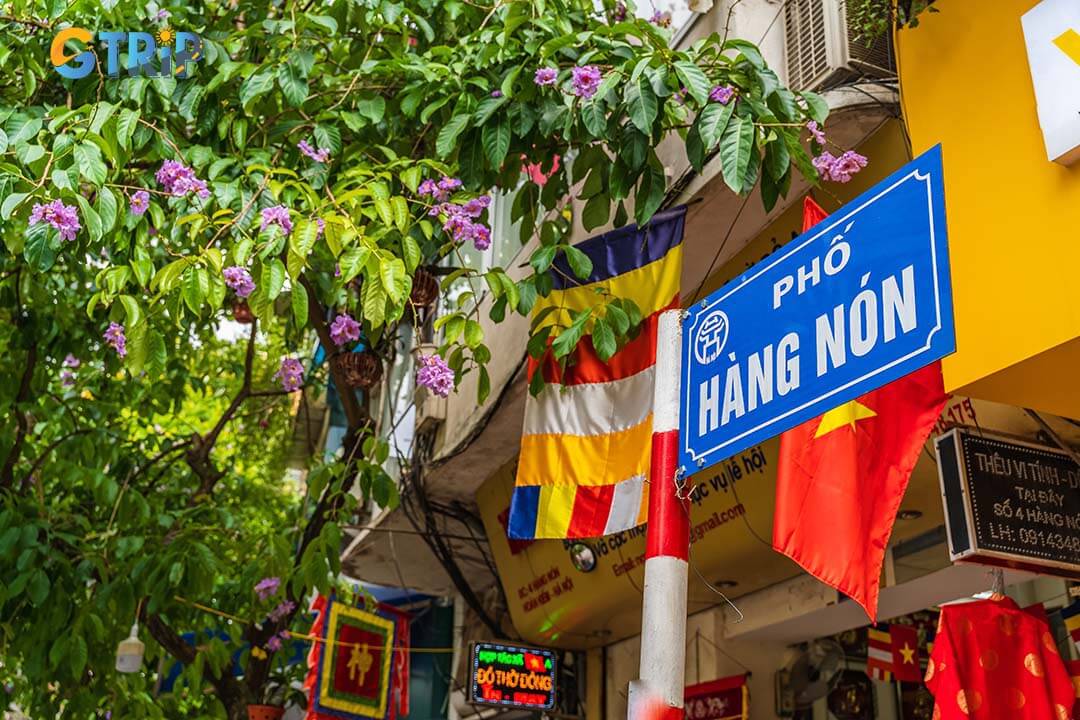
Once renowned for traditional hat-making, this street now offers handmade hats, accessories, and bedding, blending heritage with modern trade
- 30. Hang Vai Street: A hub for textile trade, renowned for fabrics, clothing, and traditional dressmaking techniques.
- 31. Hang Luoc Street: This street is called Hang Luoc because in the past, there were shops selling combs, but now they have gradually switched to "hieu hy" services.
- 32. Hang Bong Street: Formerly known as Hang Hai or Hang Bong Hai, the street specialized in wooden-soled shoes and colorful paper shoes used in spiritual rituals. Now this place sells a lot of fashion items such as suits and vestons.
- 33. Lo Su Street: In the past, there were many shops here specializing in producing coffins, but here there was also a shrine to the ancestors of carpentry and blacksmithing. Currently, all of them are gone, so only the name Lo Su remains and is a check-in place for young people because of its "Shanghai" vibe.
- 34. Bac Ninh Street: Currently called Nguyen Huu Huan Street. This place often sells wood to make houses, cabinets, beds, tables and chairs or repair temples.
- 35. Hang Tre Street: The street was named this because, in the past, it was a strip of alluvial sand along the Red River before the outer dike existed. With few houses at the time, the street front served as a yard for storing wood and bamboo and for building sawmills, cowsheds, and horse-drawn carts.
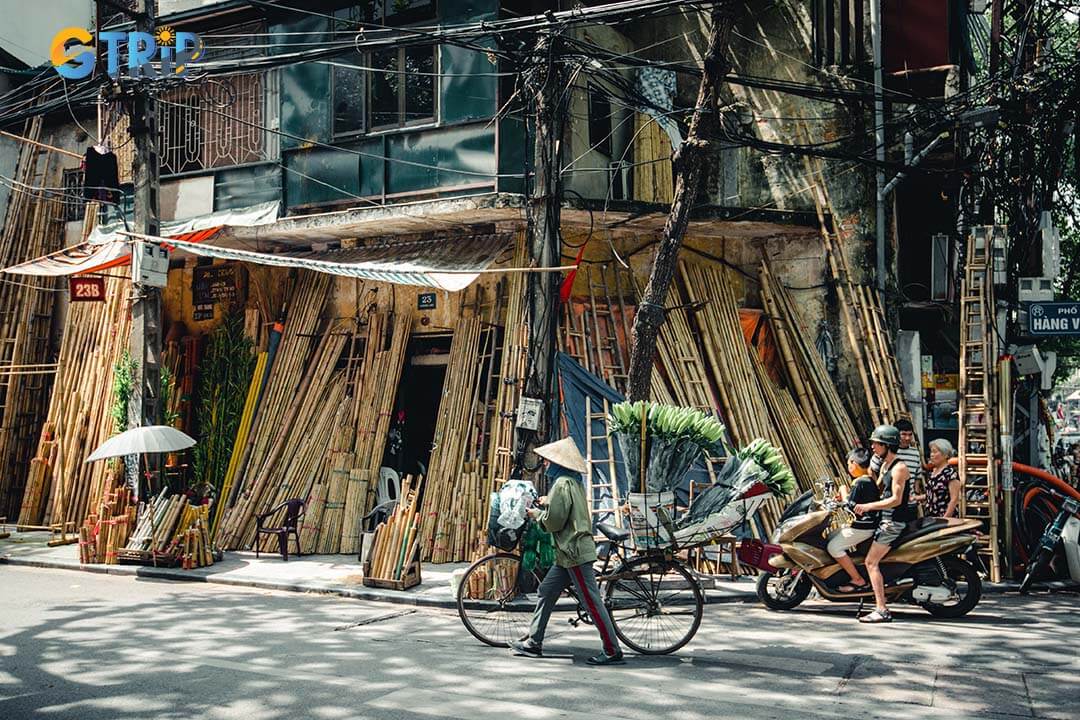
Once a sandy riverside strip, this street was used to store wood, bamboo, and carts before urban growth transformed the area
- 36. Hang Voi Street: This street used to be located near the Red River bank, convenient for boats to dock and there were many places to burn and sell lime, so it was named Hang Voi.
Note: While these historical trade associations have long defined each street, it is important to recognize that modern commerce has diversified these areas. Many of the traditional trades now coexist with contemporary shops and services, yet the names still serve as a living reminder of the Old Quarter’s rich artisan legacy.
Best 10 things to do when visiting Hanoi Old Quarter
The Hanoi Old Quarter is a captivating blend of history, culture, and bustling street life. Below are the best things to do that will make your visit unforgettable.
1. Explore the 36 Streets of Hanoi Old Quarter
Wandering through the maze-like streets of the Hanoi Old Quarter is like stepping into a living museum. Each street is traditionally named after the goods once sold there, such as Hang Bac, famous for silver jewelry, or Hang Gai, where you'll find high-quality silk products.
Take time to explore the narrow alleys filled with artisan workshops, antique shops, and cozy cafes. The architectural blend of French colonial buildings and traditional Vietnamese tube houses creates a unique atmosphere, perfect for strolling and discovering hidden gems.
2. Take a cyclo ride or ride a bicycle
A cyclo ride offers a charming way to experience the bustling streets of the Hanoi Old Quarter at a relaxed pace. These traditional three-wheeled bicycles, pedaled by locals, provide a nostalgic and immersive experience. Cyclo drivers are usually knowledgeable about the area's history and can share interesting stories as you pass iconic landmarks. The cost of a one-hour cyclo ride typically ranges from 100,000 to 200,000 VND (about $4 to $9 ) in 2025, but it's wise to agree on the fare before starting your ride.
Alternatively, renting a bicycle gives you more flexibility to explore the Old Quarter. Bicycle rentals are available near Hoan Kiem Lake at affordable rates, generally around 50,000 to 100,000 VND (about $2 to $4 ) per day. Cycling through the narrow streets lets you experience Hanoi like a local while navigating its vibrant energy.
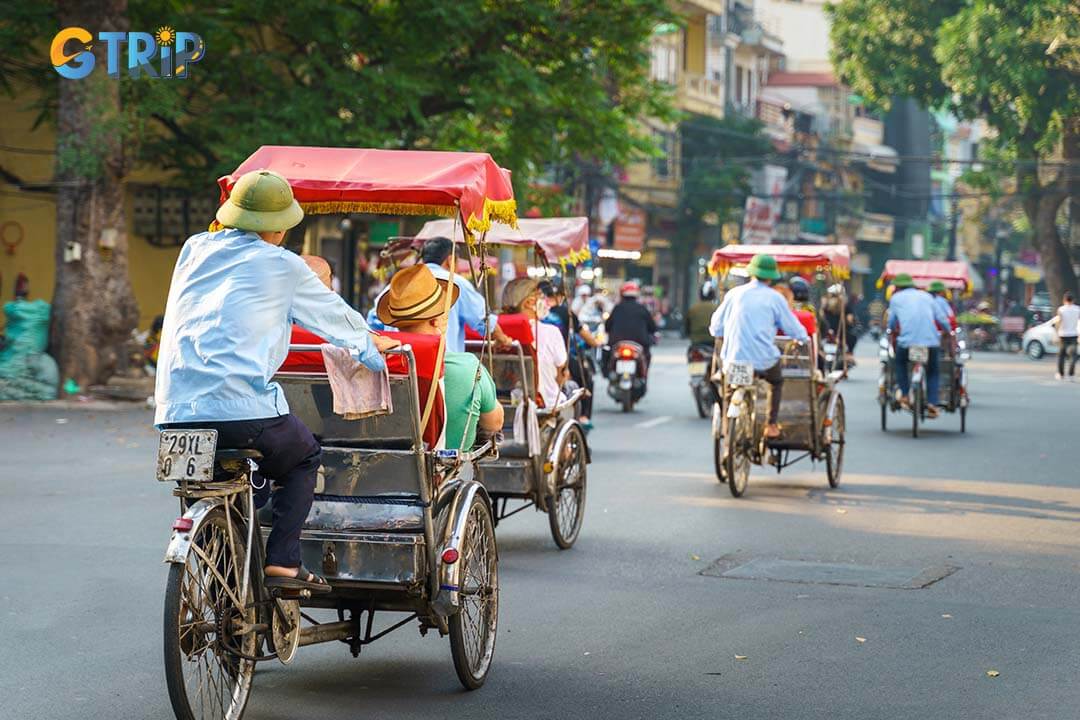
Cyclo and bike rides offer a relaxed, local way to explore the Old Quarter's vibrant streets and hidden corners
Besides, there is also a bicycle tour at night called “THANG LONG NIGHT - HANOI” that will take tourists through the National Museum of History, Hanoi Opera House, Bac Bo Palace Revolutionary Relic, Main North Gate, Hanoi Flagtower, Thang Long Imperial Citadel, Ba Dinh Square, Ho Chi Minh Mausoleum, National Assembly Building, Presidential Palace, Quan Thanh Temple, Tran Quoc Pagoda, and the final destination is Ngu Xa Pearl Island Night Food Court. You can contact the Vietnam National Museum of History or Vietnam Sustainable Tourism Development and Investment Joint Stock Company (VIETNAM S.T.I.D) to learn more about this tour.
*Note: Cyclo ride ticket prices may change in the future, and we cannot guarantee they will always be around 200,000 VND. Please contact GTrip for the latest information and assistance.*
3. Discover historic landmarks at Hanoi Old Quarter (900m from Ta Hien Street)
Begin with St. Joseph’s Cathedral, a stunning example of Gothic Revival architecture built by the French in 1886. The cathedral's towering spires, intricate stained-glass windows, and grand altar create a striking contrast to the Old Quarter's traditional charm. Early morning and late afternoon are ideal for visiting, when the cathedral's doors are open to the public, and you can witness local worshippers attending mass.
Just a short walk away, the Ancient House on Ma May Street is a beautifully preserved 19th-century home showcasing traditional Vietnamese architecture. The house features a narrow facade, a tiled courtyard, wooden balconies, and antique furniture that reflect the daily life of affluent Hanoians from the past. An entrance fee is 20,000 VND (around $0.78 ) to go into this ancient house to explore.
For those interested in exploring further, landmarks like the Bach Ma Temple, one of Hanoi's oldest temples dedicated to the city's guardian deity, and the Heritage House at 87 Ma May. Which is preserved the essence of a traditional merchant's home, provide a richer understanding of Hanoi's layered history.
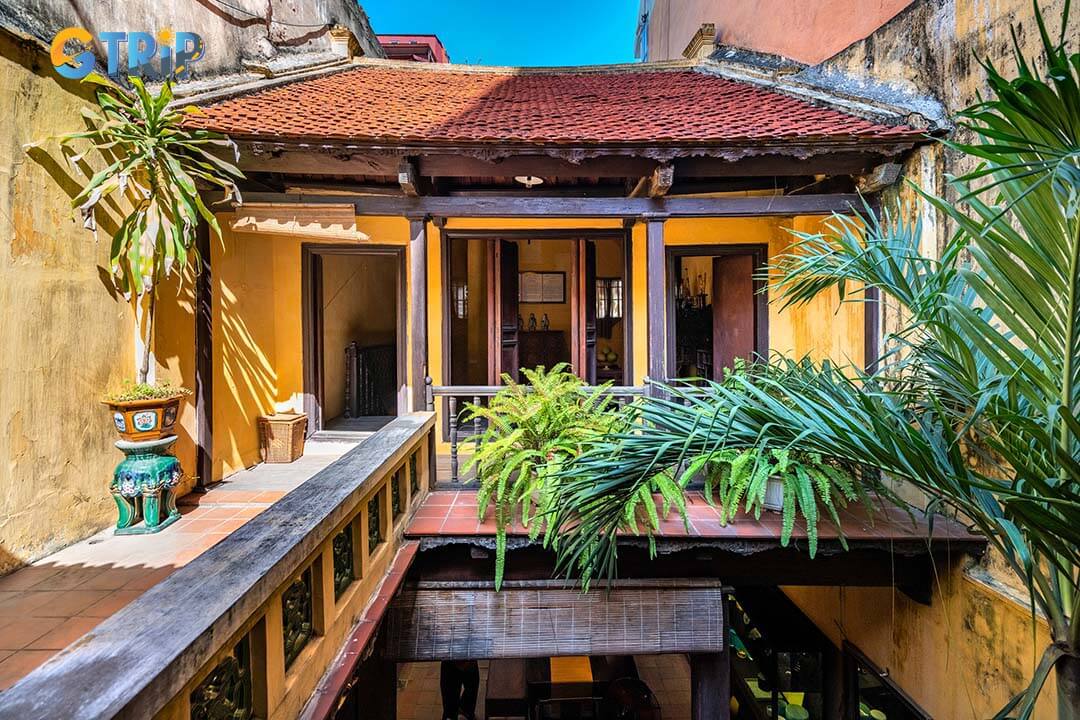
Explore heritage highlights like St. Joseph’s Cathedral, the Ancient House on Ma May, and Bach Ma Temple for a glimpse into Hanoi’s rich history and architecture
4. Visit Hoan Kiem Lake and Ngoc Son Temple (900m from Ta Hien Street)
Hoan Kiem Lake is not just a scenic spot - it is the cultural and spiritual heart of Hanoi. Known as the "Lake of the Restored Sword", it is steeped in legend. According to folklore, Emperor Le Loi received a magical sword from the Golden Turtle God to defeat Chinese invaders. After his victory, the turtle reclaimed the sword in the lake, symbolizing peace and unity.
The lake is a popular spot for locals, especially in the early morning, when you'll see people practicing tai chi, jogging, or enjoying a peaceful walk. The atmosphere at sunrise and sunset is especially enchanting, with the sun casting golden hues over the tranquil waters.
Crossing the bright red Huc Bridge leads to Ngoc Son Temple, dedicated to General Tran Hung Dao, a national hero celebrated for his defense against the Mongol invasions in the 13th century. The temple also honors the scholar Van Xuong and the god of literature, reflecting its deep spiritual and cultural significance. Inside, you'll find ancient artifacts, ceremonial altars, and the preserved remains of a giant turtle, said to be linked to the legendary sword.
The entrance fee to Ngoc Son Temple is approximately 30,000 VND (around $1.20 ) for adults, with students paying 15,000 VND and children under 15 years old entering for free. Visiting in the early morning or late afternoon is recommended to avoid crowds and enjoy the most picturesque views.
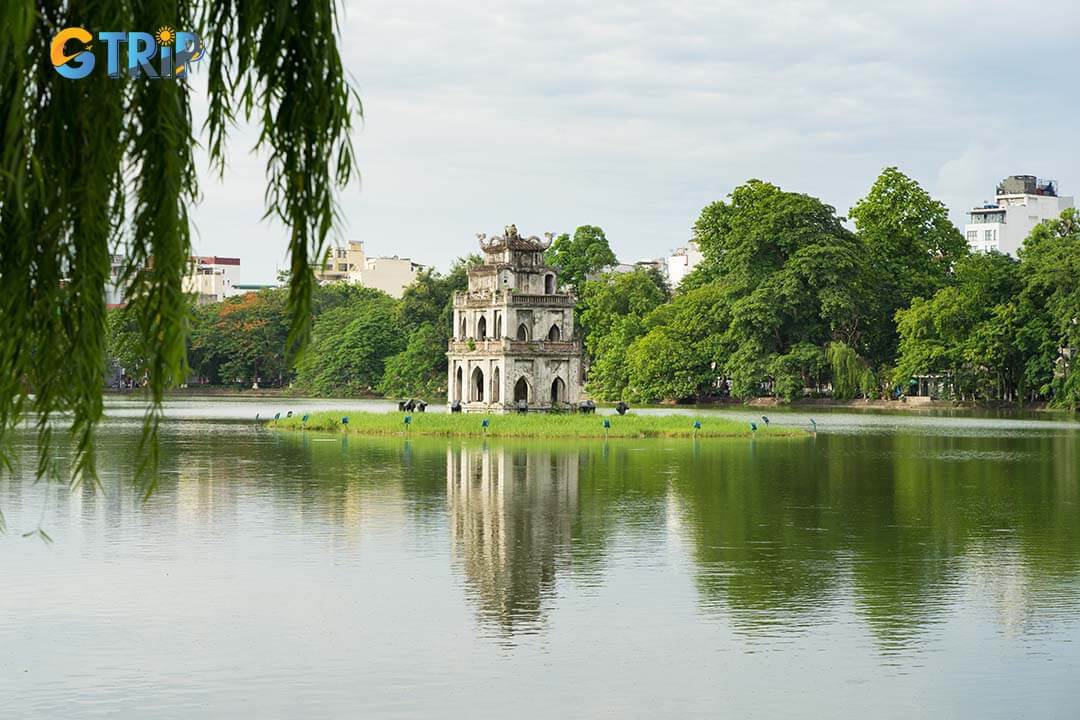
Hoan Kiem Lake, the cultural heart of Hanoi, blends legend, spirituality, and scenic beauty, with highlights like the iconic Huc Bridge and Ngoc Son Temple
5. Try local food in Hanoi Old Quarter
Hanoi Old Quarter is a haven for street food enthusiasts, offering a culinary adventure that blends Vietnamese tradition with French influences. One of the must-try dishes is pho bo (beef noodle soup). This iconic dish features a delicate, aromatic broth simmered for hours with beef bones, star anise, cinnamon, and fresh herbs. Many locals recommend enjoying it at street-side eateries like Pho Bat Dan or Pho Thin, where the recipe has been passed down through generations.
Another staple is bun cha, a flavorful combination of grilled pork patties and slices served with vermicelli noodles, fresh herbs, and a tangy fish sauce dip. To savor the best bun cha, visit Bun Cha Huong Lien, famously visited by former U.S. President Barack Obama.
For a quick, portable bite, try banh mi, a French-inspired baguette sandwich filled with a mix of pate, grilled pork, pickled vegetables, cucumber slices, and chili. Some of the best banh mi stalls include Banh Mi Pho Co and Banh Mi 25, each with its unique twist on this classic.
Don't leave without trying egg coffee (ca phe trung), a sweet and velvety treat made from whipped egg yolks, sugar, condensed milk, and robusta coffee. Cafe Giang, the birthplace of egg coffee, remains a beloved spot for this unique creation.
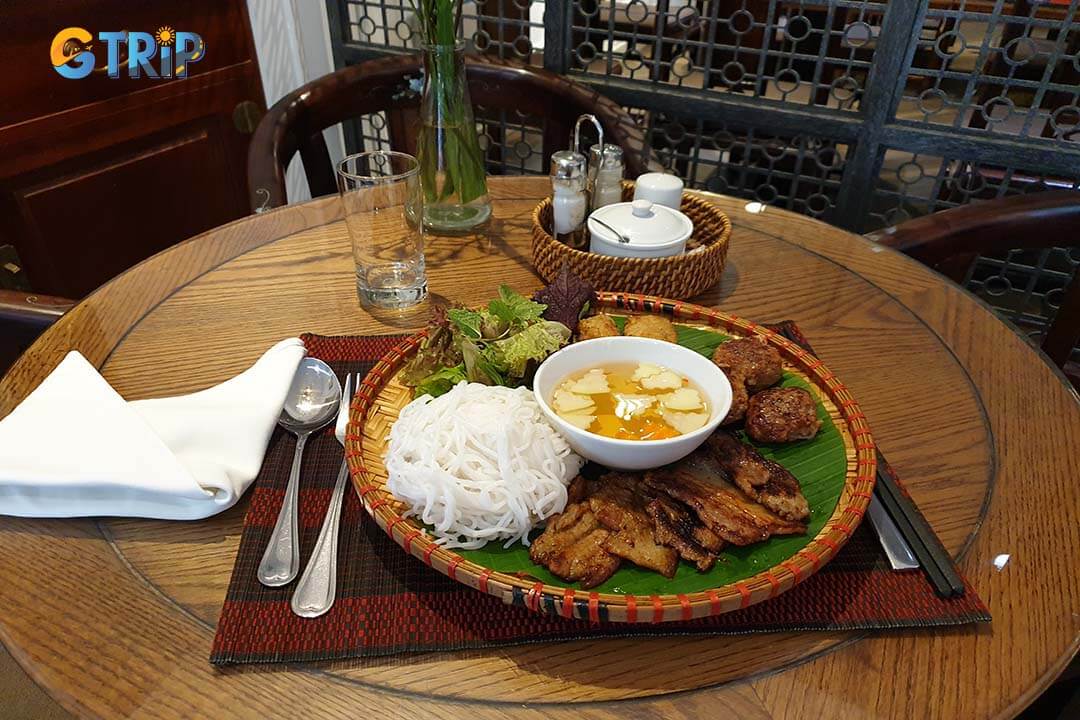
Hanoi Old Quarter is a street food haven, with must-try dishes like pho bo, bun cha, banh mi, and egg coffee
6. Enjoy beer at Ta Hien Street
Ta Hien Street, fondly known as “Beer Street", is a must-visit spot in Hanoi Old Quarter for those seeking a lively nightlife experience. This narrow, bustling street comes alive every evening with locals, expats, and tourists gathering to enjoy bia hoi - a fresh, unpasteurized, locally brewed beer.
Bia hoi is a symbol of Hanoi's drinking culture, known for its light, crisp taste and remarkably low price, typically between 7,000 - 17,000 VND (about $0.30 - $0.66 ) per glass. The beer is brewed daily, delivered to vendors, and consumed quickly to maintain its freshness. Along with beer, street vendors also serve a variety of snacks like nem chua ran (fried fermented pork rolls), fried peanuts, and grilled skewers, which pair perfectly with the cold brew.
The atmosphere on Ta Hien Street is electric, especially on weekends. Small plastic stools spill out onto the sidewalks, creating a communal, open-air bar where conversations and laughter flow freely. Street performers, live music, and a mix of languages add to the multicultural, energetic vibe.
For a more immersive experience, try sitting shoulder-to-shoulder with locals, clinking glasses while shouting "Mot, hai, ba, yo!" (One, two, three, cheers!). If you're looking for a lively, authentic, and budget-friendly night out, Ta Hien Street is the place to be.
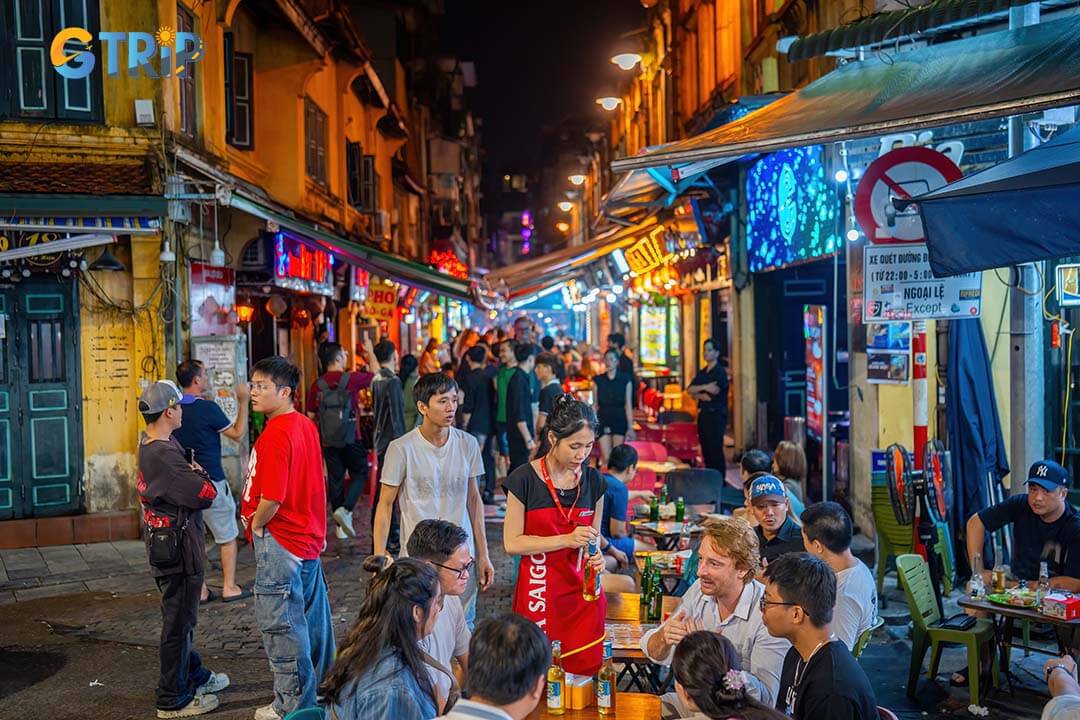
Ta Hien Street, known as “Beer Street”, is Hanoi’s go-to nightlife spot, where locals and tourists gather over fresh bia hoi and street snacks in a vibrant, open-air setting
7. Experience the night market
The Hanoi Old Quarter night market is a vibrant spectacle that takes over the streets of Hang Dao, Hang Ngang, and Hang Duong every Friday, Saturday, and Sunday evening. Stretching for over 3 kilometers, this bustling market is a lively mix of locals and tourists, creating a dynamic atmosphere that showcases the essence of Hanoi's street culture.
As you stroll through the market, you'll find an array of items, from souvenirs, traditional handicrafts, and handmade accessories to clothing, electronics, and home decor. Bargaining is a part of the experience, so don't hesitate to haggle politely for a better price. Most vendors expect it, and it can be a fun, interactive way to connect with the locals.
Beyond shopping, the night market is a paradise for street food enthusiasts. Savor banh cuon (steamed rice rolls) stuffed with minced pork and mushrooms, enjoy crispy nem chua ran (fried fermented pork), or indulge in skewers of grilled meats seasoned with Vietnamese spices. Sweet treats like che (Vietnamese sweet soup) and kem xoi (sticky rice ice cream) offer a delightful end to your culinary adventure.
Live performances, including traditional music and modern street acts, often add to the lively ambiance, making the night market more than just a place to shop, it's a cultural experience. If you're seeking a unique memento or simply enjoying the vibrant energy, the Hanoi Night Market is a must-see experience in the Old Quarter.
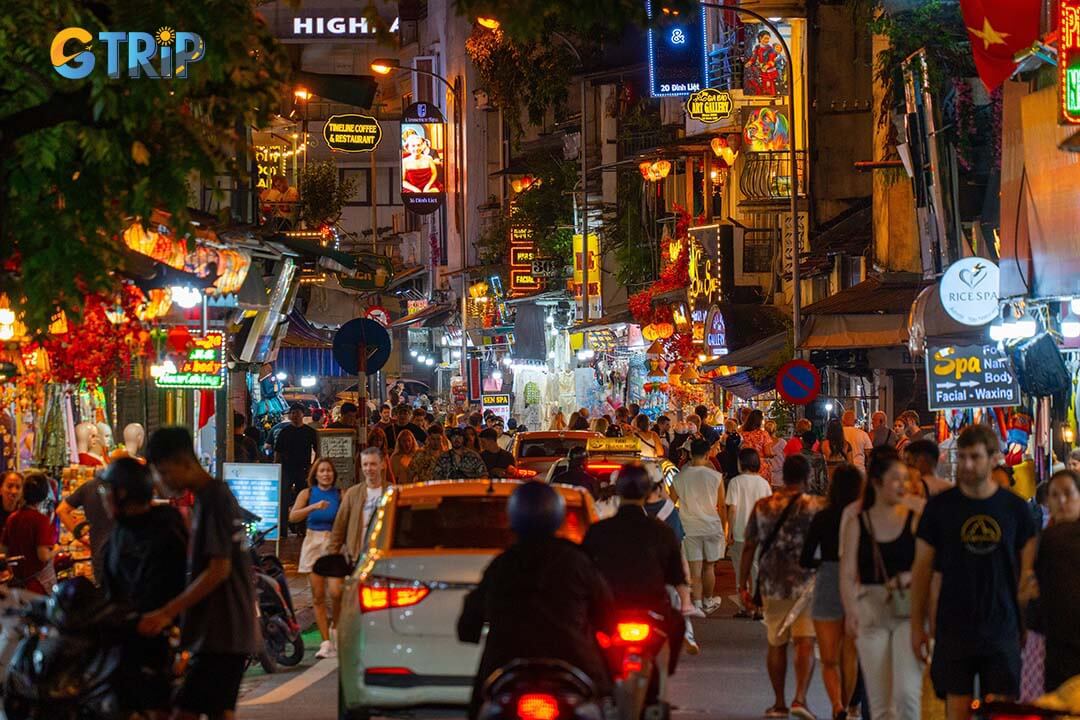
The Hanoi Old Quarter Night Market is a vibrant weekend hotspot with bustling stalls, tasty street food, and lively cultural performances
8. Watch a water puppet show at Thang Long Water Puppet Theatre
Watching a water puppet show at the Thang Long Water Puppet Theatre is a captivating experience that brings you closer to Vietnam's rich cultural heritage. Originating over a thousand years ago in the rural villages of Northern Vietnam, water puppetry was traditionally performed in flooded rice paddies during the harvest season. Today, it has become a celebrated art form, drawing audiences from around the world.
The Thang Long Water Puppet Theatre is the most famous venue for this unique performance. Skilled puppeteers, hidden behind a screen and standing waist-deep in water, manipulate wooden puppets on a water stage. The puppets depict scenes from Vietnamese folklore, legends, and rural life, from the heroic tales of General Tran Hung Dao to charming depictions of farmers cultivating rice.
Accompanied by live traditional music performed on authentic instruments like the dan bau (monochord) and dan nhi (two-stringed fiddle), the show is a sensory experience. The lively narration and traditional singing in the Northern Vietnamese dialect add to the authenticity, though non-Vietnamese speakers can still enjoy the universal storytelling and visual artistry.
Showtimes are usually available throughout the day, with performances lasting around 50 minutes. Tickets cost between 100,000 - 200,000 VND (about $4 - $8), and it's recommended to book in advance, especially during peak tourist seasons. Experiencing a water puppet show at Thang Long Theatre offers a unique glimpse into Vietnam’s cultural heritage.
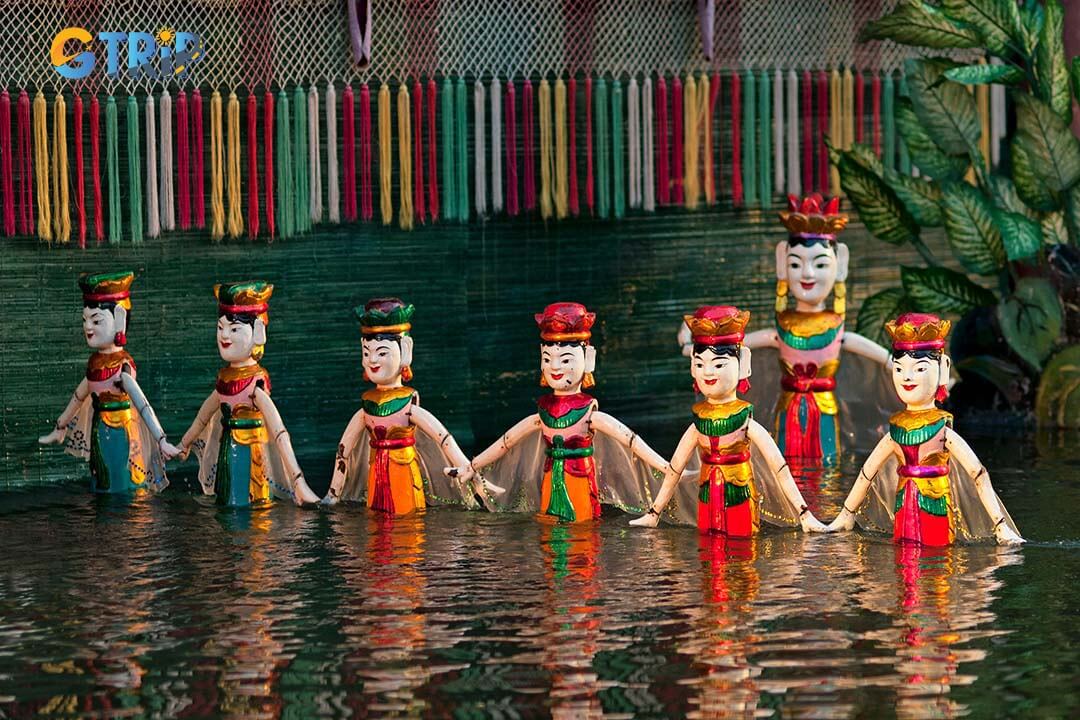
Thang Long Water Puppet Theatre brings Vietnamese folklore to life with wooden puppets performing on water, accompanied by live traditional music
9. Capture street photography in Hanoi Old Quarter
The Hanoi Old Quarter is a treasure trove for street photographers, offering a unique blend of history, culture, and daily life. Its maze-like streets blend ancient architecture with modern shops, traditional trades with trendy cafes, and the rhythmic chaos of motorbikes in narrow alleys.
Early mornings provide a serene atmosphere as the city awakens. Street vendors set up their stalls, monks collect alms, and locals gather for breakfast at street-side eateries. This quiet yet lively period allows for candid shots that reflect the essence of Hanoi. Late afternoons and early evenings bring a different dynamic, with golden light casting a warm glow on aging colonial façades and rustic tube houses.
Top street photography spots include Dong Xuan Market, with its vibrant stalls, and Train Street, where trains pass through a narrow alley just inches from homes. Explore Hang Ma Street during festival seasons for vibrant displays of lanterns, decorations, and traditional crafts. Engage with locals when appropriate, is a simple smile or greeting can open doors to more authentic moments. Remember to respect privacy, especially in religious or sensitive areas, and seek permission when photographing individuals closely.
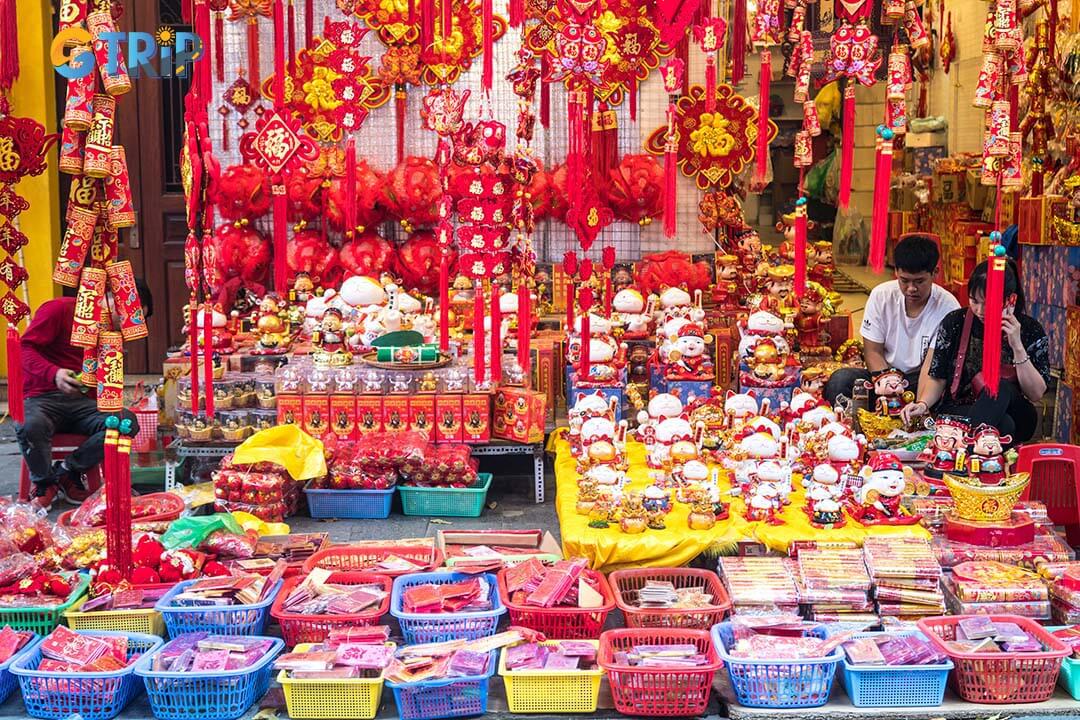
A street photographer’s paradise, Hanoi Old Quarter offers rich scenes of daily life, historic charm, and vibrant markets across its winding alleys and iconic landmarks
10. Experience coffee at the unique Train Street Hanoi
One of Hanoi's most distinctive attractions, Train Street, offers a thrilling yet charming experience where visitors can sip coffee just inches away from a passing train. Located in the Old Quarter, this narrow street is lined with rustic cafes, where tables and chairs are set up close to the railway tracks.
The main draw here is the spectacle of the train passing by mere feet away from the cafes - an event that occurs several times a day. As the train approaches, café staff quickly clear the tables and chairs, creating a blend of excitement and slight suspense. Once the train passes, the street returns to its relaxed, cozy atmosphere.
While enjoying this unique experience, try classic Vietnamese coffee varieties like egg coffee, iced coffee with condensed milk, or stronger black coffee. The combination of rich flavors, the buzz of the railway, and the vibrant street life create a memorable moment for any visitor.
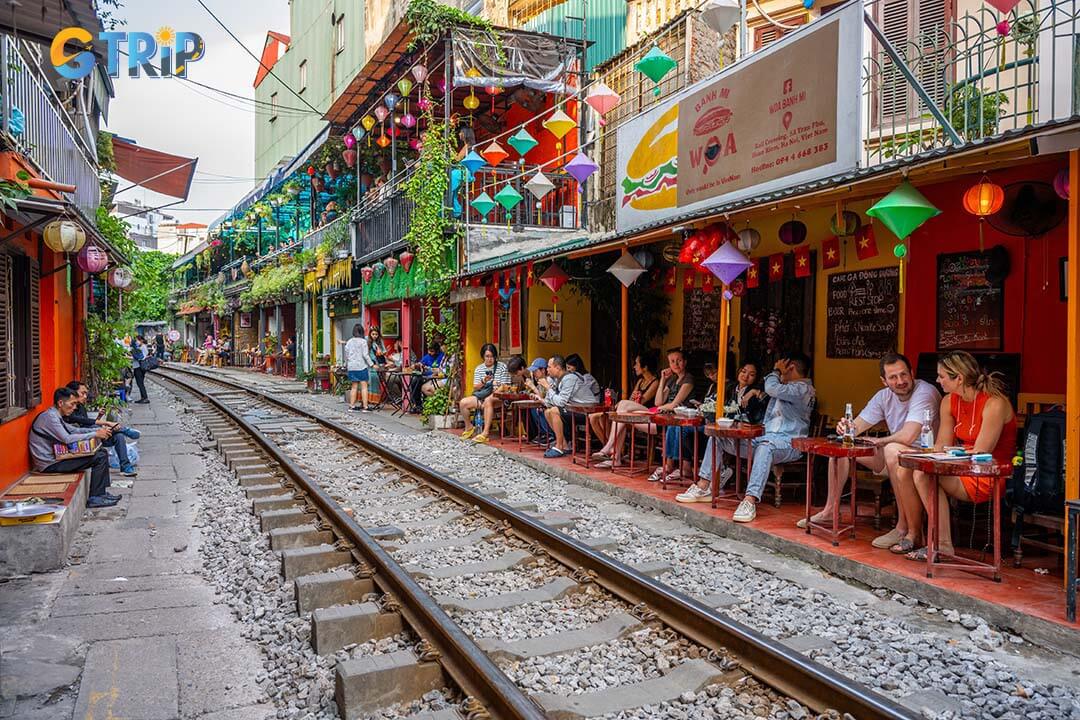
Train Street offers a one-of-a-kind experience where visitors enjoy coffee just inches from passing trains, blending thrill with Hanoi’s cozy street charm
To ensure a safe and enjoyable visit, check the train schedule before heading to Train Street, as safety measures are strictly enforced. The best time to visit is typically in the afternoon when the area is lively but not overly crowded.
Cultural insights and local life at Ha Noi Old Quarter
In the heart of Hanoi’s Old Quarter, cultural insights and local life merge into a vibrant tapestry of traditions and everyday experiences.
Traditional crafts and artisan workshops
The Hanoi Old Quarter is a living testament to Vietnam's rich artisan heritage. Many of the streets in this district bear the names of traditional crafts, a reflection of their historical roles as specialized guilds. These include Hang Bac (Silver Street), famous for its intricate silverwork, and Hang Dong (Copper Street), where craftsmen shape brass and copper into elaborate household items.
In addition to these longstanding trades, the Old Quarter has embraced modern artistic expressions while preserving traditional skills. Artisans can be found weaving silk, crafting paper fans, and producing intricate lacquerware. Some workshops offer hands-on experiences for tourists, allowing them to understand the meticulous effort required to produce these exquisite crafts. These interactions help preserve these crafts and provide income for the local community.
Key artisan experiences include:
- Lacquerware workshops: Known for their glossy finish and vibrant colors, lacquer items are significant in Vietnamese culture.
- Silk weaving: Hang Gai Street is renowned for high-quality silk products. You can witness the traditional silk weaving process, a practice dating back to the Ly Dynasty.
- Pottery and ceramics: Bat Trang Village, located just outside Hanoi, supplies the Old Quarter with its renowned ceramics, a blend of functionality and artistic expression.
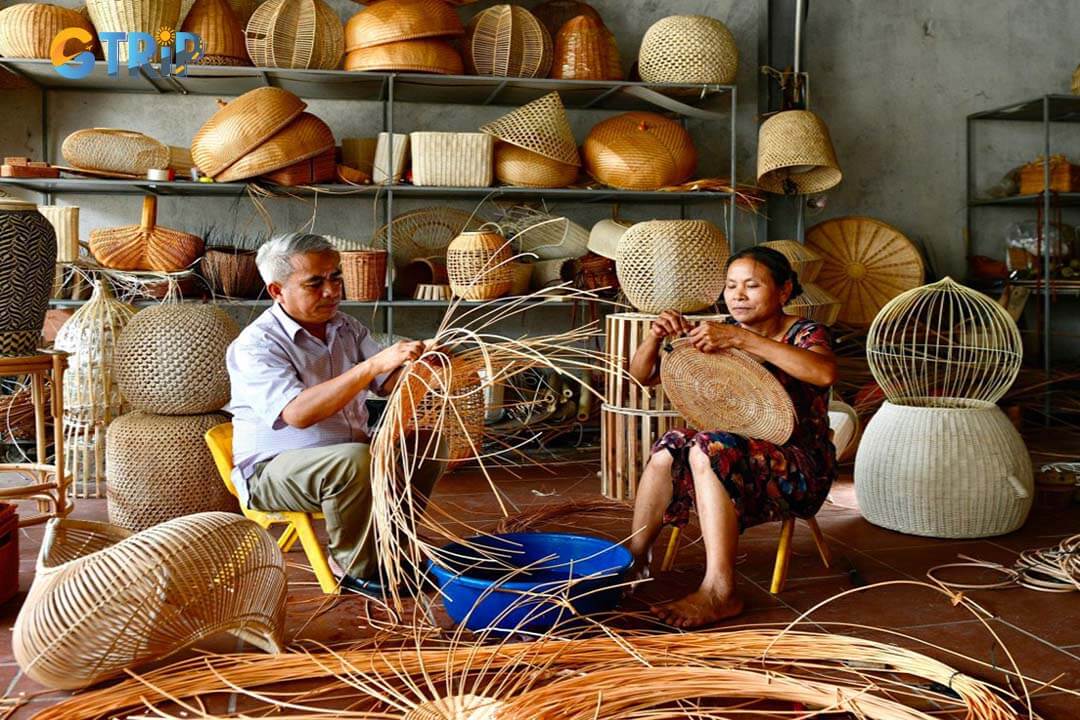
The Old Quarter showcases Vietnam’s traditional crafts, from silverwork to silk weaving, with artisan shops and hands-on cultural experiences
These artisan traditions are not merely remnants of the past; they continue to influence the cultural fabric of the Old Quarter. As the city modernizes, these crafts serve as a bridge between history and contemporary culture.
Daily life: Markets, festivals, and community events
The Old Quarter is a hub of daily commerce and communal interaction. Dong Xuan Market, the largest indoor market in Hanoi, serves as the area's commercial heart. Beyond being a shopping destination, it reflects the rhythms of local life, from early morning produce trades to late-night wholesale activities.
Traditional festivals and events breathe life into the Old Quarter:
- Tet Nguyen Dan (Lunar New Year): The most significant festival of the year, where the streets burst with color, traditional decorations, and ceremonial activities.
- Mid-Autumn Festival: Characterized by lion dances, mooncakes, and vibrant lantern displays. Hang Ma Street is particularly lively during this time.
- Local markets: Beyond Dong Xuan, smaller markets like Hang Be and Hom Market offer a glimpse into the daily routines of residents. These markets are spaces where locals bond, barter, and build community ties.

The Old Quarter buzzes with daily commerce and cultural life, centered around Dong Xuan Market and celebrated through vibrant festivals
The Hanoi Old Quarter is a living museum of Vietnam's cultural heritage. The balance between preserving traditional practices and embracing modernity creates a unique atmosphere, offering visitors a genuine glimpse into the city's heart and soul.
Best times of the day to visit
When planning your exploration of the Hanoi Old Quarter, timing plays a crucial role in maximizing your experience. The narrow, bustling streets can become overwhelmingly crowded, especially during peak hours. To capture the authentic essence of the area while avoiding excessive crowds, consider these ideal visiting times:
- Early morning (6:00 AM - 9:00 AM): The streets are waking up, offering a tranquil atmosphere ideal for morning walks and photography. You'll see locals exercising around Hoan Kiem Lake and setting up their market stalls. Morning hours are also perfect for enjoying a traditional Vietnamese breakfast, like pho or banh mi, from local vendors.
- Late afternoon to early evening (4:00 PM - 7:00 PM): As the day cools down, the streets become more vibrant with locals finishing work and street vendors preparing for the evening rush. This is a great time to explore the Hanoi Night Market, especially on weekends when it’s pedestrian-only. The golden hour light adds charm to the French colonial architecture, making it a photographer's delight.
- Night (after 9:00 PM): While most shops may close by this time, Hanoi's street food culture comes alive at night. Trying a late-night bowl of bun cha or sipping a glass of bia hoi (fresh beer) along Ta Hien Street offers a glimpse into the local nightlife.
Local etiquette, safety, and transportation
Respecting local customs and traditions enriches your experience and shows appreciation for the culture. Keep these etiquette tips in mind:
- Dressing appropriately: Although Hanoi Old Quarter is a tourist-heavy area, it’s still essential to dress modestly when visiting temples and religious sites.
- Polite communication: Vietnamese people value politeness. A gentle greeting like “Xin chao” (hello) or “Cam on” (thank you) goes a long way. Avoid pointing fingers and patting someone’s head, as these are considered disrespectful.
- Negotiating prices: Bargaining is common in markets like Dong Xuan, but keep it friendly. Smile and remain polite if you cannot reach an agreement.
While the Hanoi Old Quarter is generally safe, it's crucial to stay cautious in crowded areas to avoid pickpocketing. Here are a few tips:
- Secure your belongings: Keep bags zipped and worn in front of you, especially in busy markets.
- Street crossing: The chaotic traffic can be intimidating. Walk confidently at a steady pace - motorbikes and cars will maneuver around you. Avoid sudden stops or changes in direction.
- Scams and overcharging: Be cautious with unsolicited tour offers and check prices before ordering food or services. Using apps like Grab for transportation can help prevent overcharging.
Navigating the Old Quarter can be both exciting and challenging. Here’s how to get around effectively:
- Walking: The best way to explore the intricate alleys is on foot. Make use of offline maps or apps like Google Maps for guidance.
- Cyclo rides: Traditional three-wheeled cyclos offer a slower, nostalgic way to explore. Be sure to agree on the price beforehand.
- Motorbike taxis: Apps like Grab or Be offer safe, affordable motorbike taxi services. Helmets are mandatory, and these services often provide them.
- Electric carts: Available near Hoan Kiem Lake, these eco-friendly vehicles are ideal for quick tours around the area.

Respect local customs, stay polite, and explore safely on foot, by cyclo, or ride apps
FAQs about Hanoi Old Quarter
Planning a trip to Hanoi's Old Quarter can spark excitement and curiosity especially for first-time visitors. The Old Quarter’s vibrant streets offer an immersive experience, but smart travel and cultural awareness enhance the journey. Below are some of the most frequently asked questions to help make your visit smoother and more enjoyable.
How accessible is the Old Quarter for international travelers?
The Old Quarter is quite accessible for international visitors. English is commonly spoken in tourist areas, and many signs include English translations. However, due to the narrow and bustling nature of the streets, mobility can be challenging for travelers with disabilities. For those requiring additional assistance, it’s best to contact hotels or tour operators in advance to arrange for guided tours or transportation options that accommodate special needs.
How can I avoid tourist traps while shopping?
To avoid overpriced souvenirs, look for locally owned stores away from the main tourist hubs. Compare prices at different stalls, and don’t be afraid to bargain politely. Reading recent travel reviews and seeking recommendations from locals can also help identify authentic shops rather than tourist-targeted stalls.
Where can I find clean and safe public restrooms in the Hanoi Old Quarter?
Public restrooms in the Old Quarter can be limited, but you can find clean facilities in shopping centers, museums, and major tourist attractions. Many cafes, restaurants, and hotels also have restrooms, and staff are generally accommodating if you ask politely. It's a good idea to carry a small pack of tissues and hand sanitizer, as some restrooms may not provide these.
Can I drink tap water in the Hanoi Old Quarter?
It's generally recommended not to drink tap water in Hanoi Old Quarter due to potential contamination. Instead, opt for bottled water, which is widely available at convenience stores, supermarkets, and street vendors. Most hotels and accommodations provide complimentary bottled water for guests. If you prefer a more sustainable option, consider bringing a reusable water bottle with a built-in filter.
Read more:
Hanoi Old Quarter is the historic heart of the capital, where culture, history, and vibrant street life come together. Exploring its markets, traditional dishes, and cultural sites offers travelers a deeper connection to the city’s timeless charm. For an authentic experience, check out detailed guides from GTrip - Vietnam Agency Travel or connect with local experts for personalized insights.

